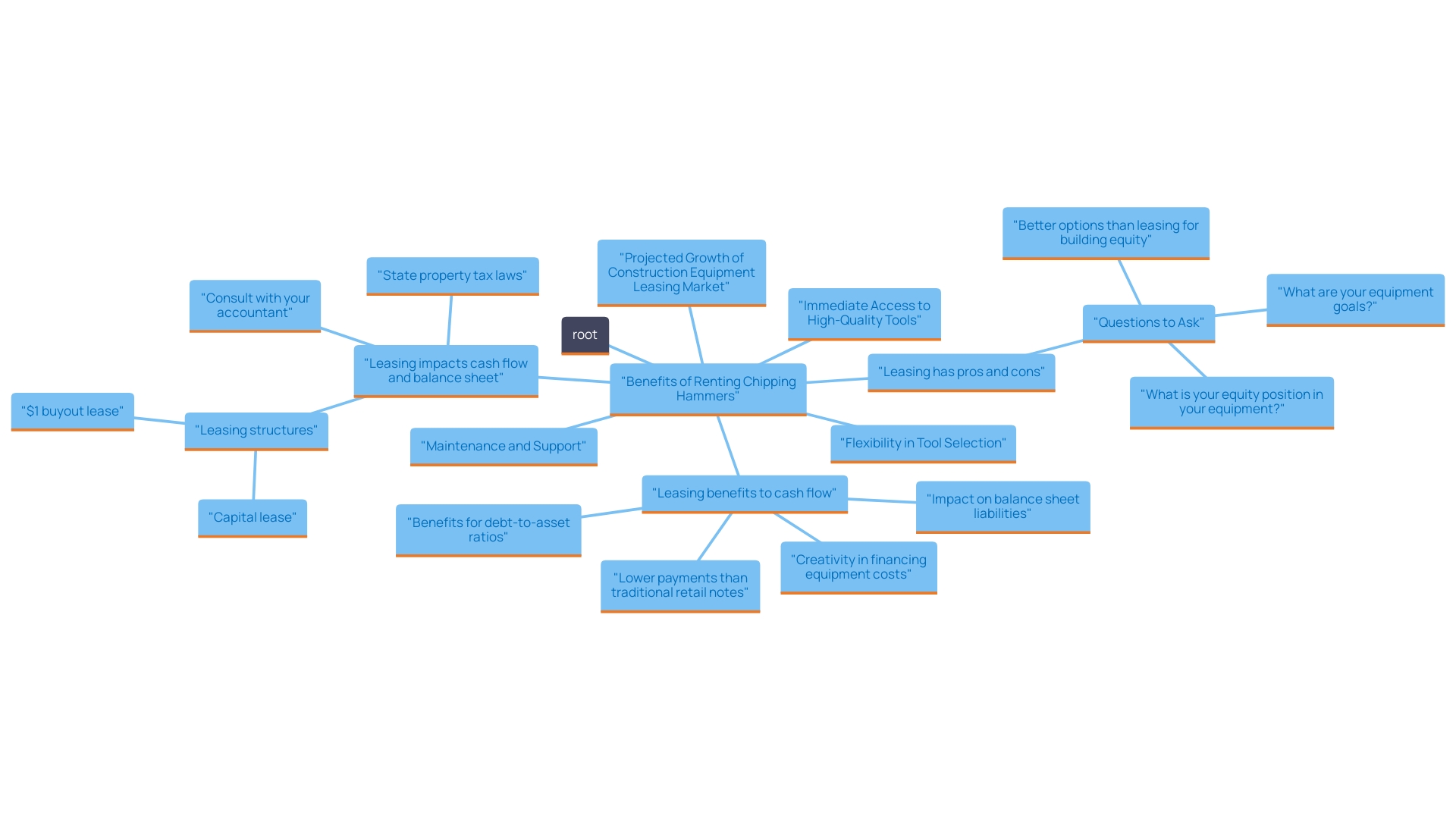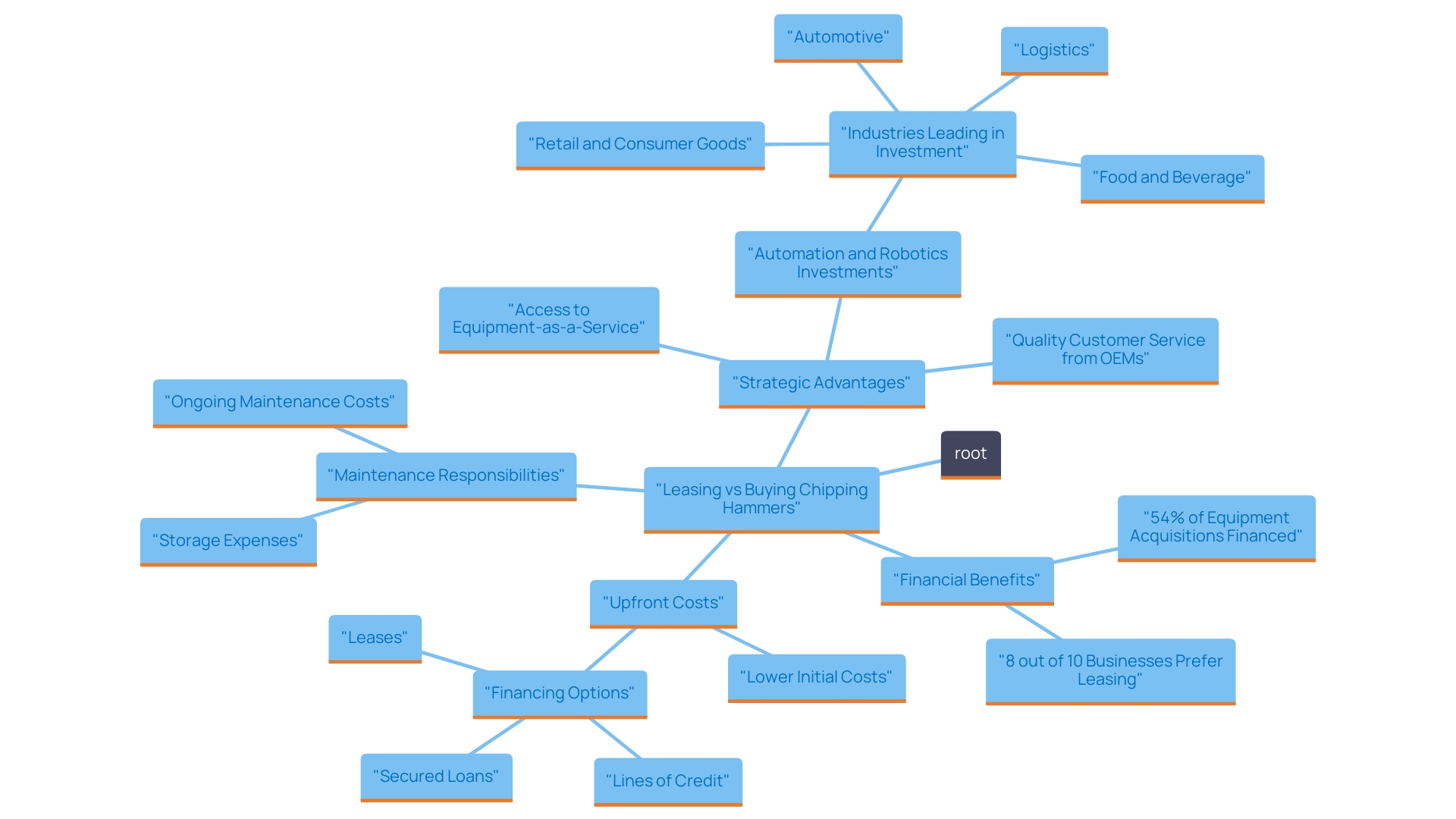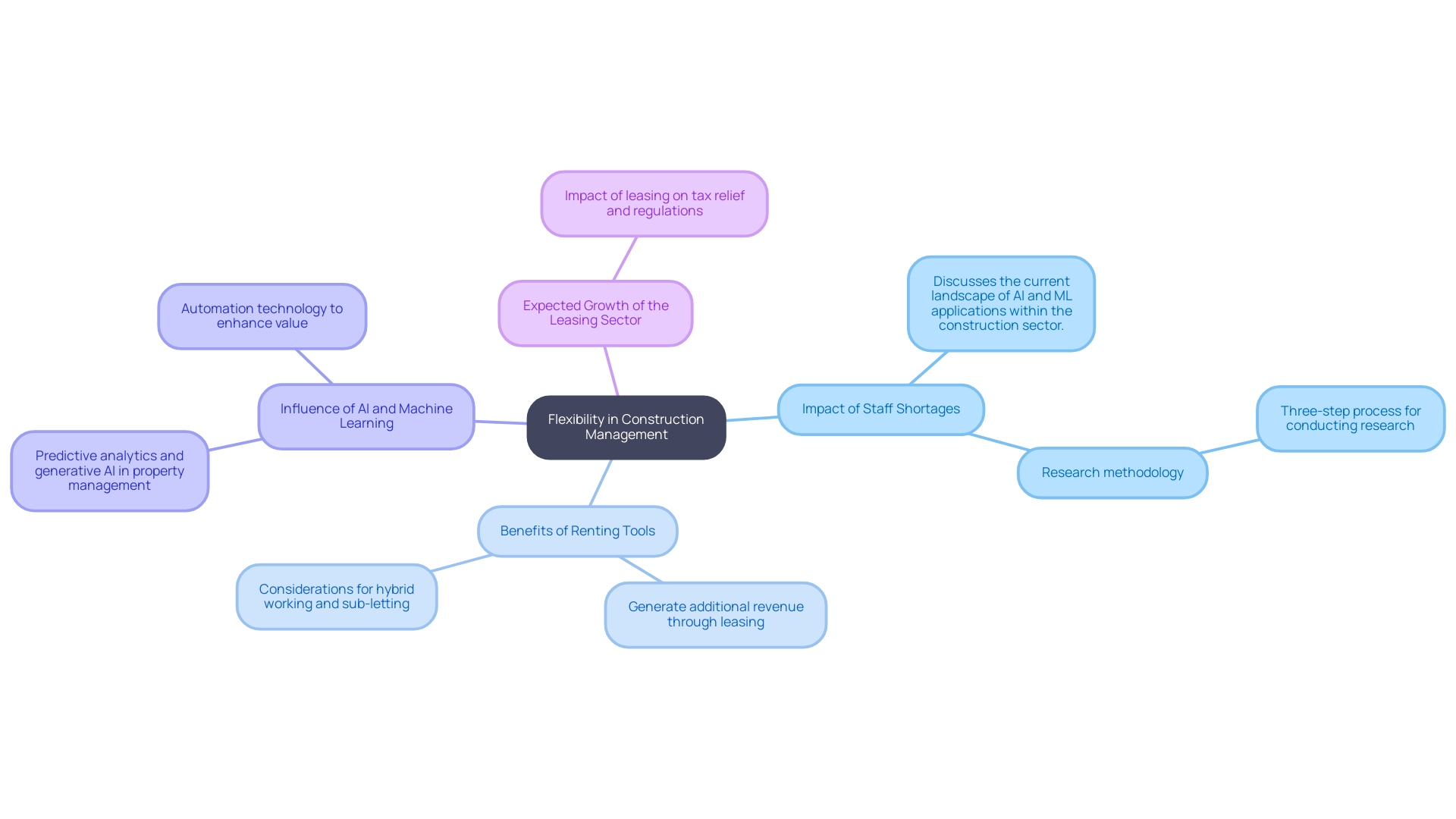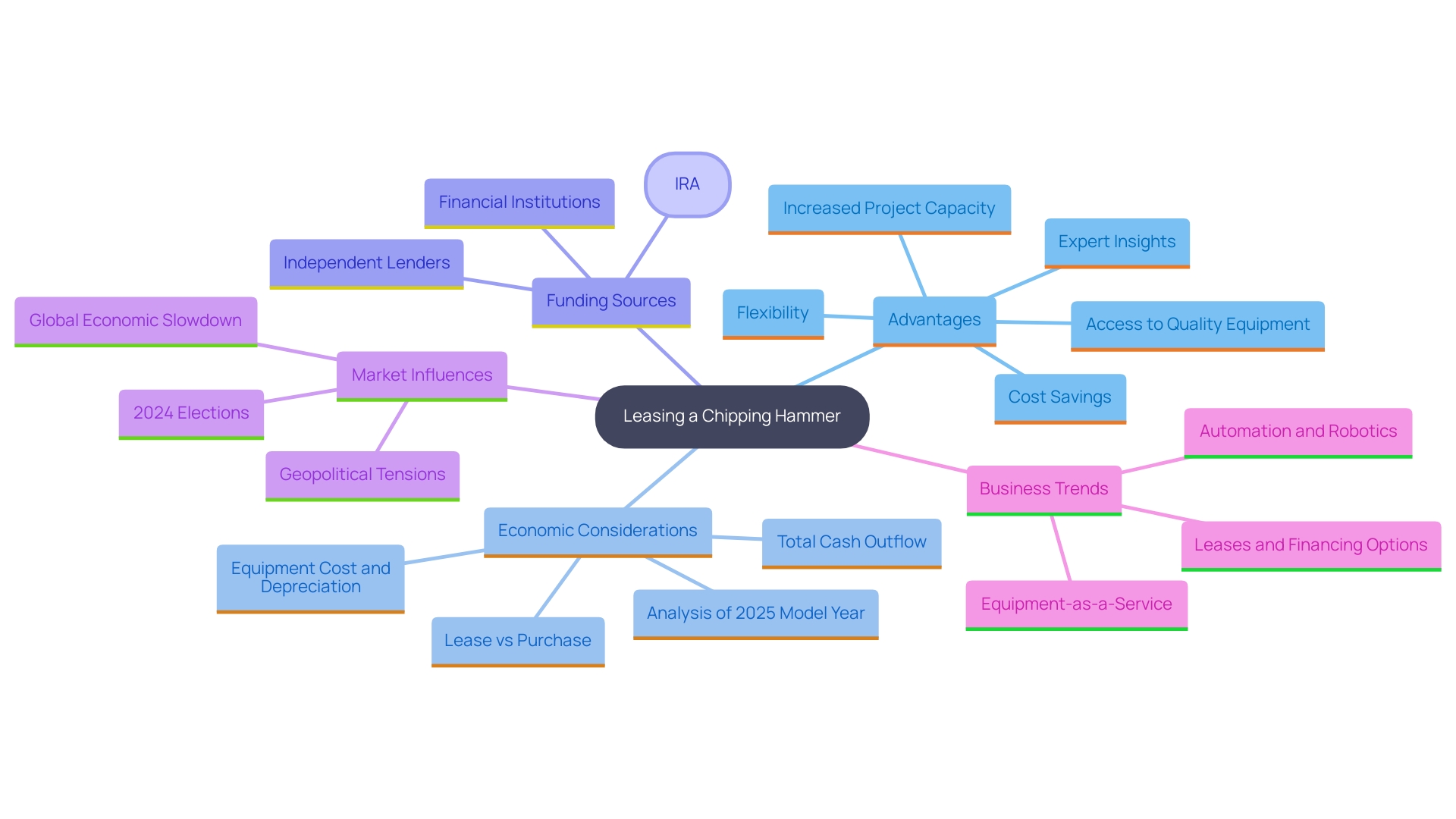Introduction
In the competitive landscape of construction, decision-makers constantly seek ways to optimize resources and enhance project efficiency. Renting a chipping hammer has emerged as a strategic solution, offering contractors immediate access to high-quality equipment without the financial burden of ownership. This approach not only alleviates upfront costs but also provides the flexibility to adapt to varying project demands.
As the construction equipment rental market continues to expand, understanding the advantages of renting versus buying becomes crucial for maximizing productivity and minimizing operational challenges. Through insightful case studies and expert opinions, this article delves into the myriad benefits of renting chipping hammers, helping professionals make informed choices that drive success in their projects.
Top Advantages of Renting a Chipping Hammer
Renting a chipping hammer offers a myriad of benefits tailored to the needs of professional contractors. One of the primary advantages is the immediate access to high-quality tools without the substantial upfront investment of purchasing. This enables the efficient implementation of initiatives without the financial burden linked to ownership. Furthermore, lease contracts generally encompass maintenance and support, ensuring the devices stay in optimal condition and removing the concern of possible repairs.
Flexibility is another key benefit. Users can choose the specific model required for a particular task and return it upon completion, thereby avoiding the inconvenience of storing infrequently used tools. This adaptability is crucial in the construction industry, where project requirements often vary.
Statistics indicate that the global construction equipment leasing market is projected to grow at a 6.0% CAGR from 2024 to 2032, reflecting the increasing preference for renting over owning. This trend is backed by significant market participants, who make up roughly 45%-50% of the market share, highlighting the strong demand for leasing services due to their extensive presence and brand reputation.
For instance, a recent project in a metropolitan area required extensive concrete demolition, and the contractor opted to rent a chipping hammer instead of purchasing one. This decision not only but also provided access to the latest models, which enhanced productivity and efficiency on site.
Moreover, real-world examples, such as the segmentation analysis of the global construction equipment leasing market, reveal significant revenue growth trends and industry dynamics that align with these advantages. Companies such as H&E Equipment Services Inc., which opened its 22nd leasing location in Texas, illustrate the expanding reach and accessibility of service offerings, making it easier for contractors to obtain the tools they require when they need them.
Expert insights further underscore these advantages. Brian Moore, VP of NICCA USA, Inc., commended the quality of research in the sector, emphasizing the value provided by rental options. This blend of financial savings, operational flexibility, and expert assistance makes leasing chipping hammers a strategic option for construction managers.

Cost-Effective Solutions: Renting vs. Buying a Chipping Hammer
Analyzing the financial aspects of leasing versus buying a chipping hammer reveals significant cost benefits for many users. Upfront costs for acquiring tools can be substantial, especially for specialized items that may only be necessary for short-term projects. For instance, purchasing a chipping hammer can surpass $1,000, while borrowing the same tool usually costs only a few hundred dollars each week, with typical borrowing fees often around $200 to $300 depending on the company.
Rob Coakley, a manager for Lithko Contracting, emphasizes the strategic advantage of knowing when to rent or buy, suggesting that understanding this balance can enhance your asset management and cost strategy. Leasing not only provides a lower initial cost but also shifts responsibilities such as maintenance, storage, and depreciation to the leasing company. This shift can free up valuable resources and time, allowing businesses to focus on core operations.
A case study from Lithko Contracting illustrates how leasing heavy equipment can streamline operations by shifting maintenance responsibilities to the rental company, thereby freeing up valuable time and resources. As Holt of California states, 'Please don’t hesitate to contact us so we can discuss your needs and how Holt of California can help your business progress into the future.'
For smaller contractors or individuals engaging in occasional tasks, leasing proves to be a financially wise solution. The cost-effectiveness of leasing, combined with the elimination of maintenance and storage expenses, makes it an attractive option. By carefully evaluating the usage of tools, contractors can make informed decisions that align with their financial and operational goals. In summary, leasing chipping hammers not only lowers initial expenses but also eases ongoing responsibilities, making it a strategic option for many construction endeavors.

Flexibility and Accessibility in Project Management
Flexibility plays a crucial role in the effective management of construction activities, and renting a chipping hammer significantly enhances this flexibility. With 73% of professionals in the field reporting staff shortages due to the pandemic, the ability to is more critical than ever. By choosing to lease tools, managers can swiftly [adapt to changing job site needs](https://blog.ezequipmentrental.com/why-industrial-sweeper-rental-is-essential-for-construction-success), ensuring that tasks stay on course.
For example, if a quicker deadline requires an extra chipping hammer, renting offers a fast solution without the delays linked to acquiring new tools. This approach not only saves time but also enhances accessibility, allowing teams to utilize specialized tools that may not be frequently employed, thus avoiding unnecessary investments.
In the fast-paced construction environment, where responsiveness is paramount, this level of adaptability can greatly influence results. Case studies from the Middle East and Africa emphasize the significance of tool leasing in effectively addressing task requirements, especially as the leasing sector is anticipated to expand by 5.8% due to major developments such as Neom City and Lusail City.
Furthermore, expert perspectives highlight that incorporating AI and machine learning into management tools can improve forecasting precision and resource distribution, which complements the advantages of adaptable asset rental. These technologies can help managers anticipate needs and make informed decisions about renting equipment, further streamlining operations. Bain & Company discovered that adopting agile practices can result in a 41% enhancement in the predictability of success, highlighting the importance of a responsive and adaptable method in construction management.
In conclusion, the significance of adaptability in management cannot be overstated. By utilizing rental tools, project managers can not only tackle immediate challenges but also cultivate a more agile and efficient work environment, ultimately resulting in enhanced project outcomes.

Conclusion: Making Informed Equipment Choices
Acknowledging the key advantages of leasing a chipping hammer can profoundly influence decision-making for contractors and homeowners alike. Renting offers unparalleled flexibility, allowing users to select the right tool for specific tasks without the long-term commitment of a purchase. This approach can lead to significant cost savings, as it eliminates the need for large upfront investments and reduces maintenance expenses. In fact, statistics indicate that leasing can save contractors up to 50% on machinery expenses compared to buying outright.
Moreover, leasing offers prompt access to top-notch, well-kept equipment, guaranteeing that tasks are accomplished effectively and to a high standard. A case study involving independent contractors demonstrated that those who rented tools were able to increase their project capacity by 30%, showcasing how informed choices can enhance productivity and project outcomes.
Specialist perspectives highlight the importance of leasing tools. Craig Gramlich, a Certified Equipment Manager, notes that the growing interest in equipment rental is driven by the necessity to optimize the utility of equipment and maximize value. He states, "The shift towards leasing allows contractors to stay competitive and adaptable to changing task requirements," which reflects the broader market trend where leasing is becoming an increasingly favored solution among construction firms.
Ultimately, the should align with specific objectives, budget constraints, and long-term use considerations. By carefully weighing these factors and considering the substantial savings and efficiency gains that renting can offer, construction project managers can ensure the most effective use of resources, leading to successful and cost-effective project execution.

Conclusion
Renting a chipping hammer presents numerous advantages that can significantly enhance the efficiency and cost-effectiveness of construction projects. Immediate access to high-quality equipment without the burden of hefty upfront costs allows contractors to focus on project execution rather than financial strain. Moreover, the flexibility to choose specific models tailored to project requirements enables teams to adapt swiftly to changing demands, ensuring they remain agile in a competitive environment.
Financially, the comparison between renting and purchasing highlights substantial savings. With rental costs typically a fraction of the purchase price, contractors can allocate their resources more effectively, transferring responsibilities for maintenance and storage to rental companies. This not only reduces operational expenses but also frees up valuable time and manpower, allowing teams to concentrate on core project activities.
The importance of flexibility in project management cannot be overstated. In an industry where timelines and requirements frequently shift, the ability to quickly adjust equipment needs can be the difference between meeting deadlines and falling behind. By integrating rental options into their strategies, construction managers can enhance their responsiveness and improve overall project outcomes.
In summary, the decision to rent rather than buy a chipping hammer can lead to significant operational and financial benefits. By leveraging the advantages of renting, contractors can optimize their equipment management, minimize costs, and ultimately drive successful project execution. As the construction equipment rental market continues to expand, embracing this approach will be crucial for professionals aiming to thrive in an ever-evolving industry.
Frequently Asked Questions
What are the main benefits of renting a chipping hammer for contractors?
Renting a chipping hammer provides immediate access to high-quality tools without the substantial upfront investment of purchasing. It also includes maintenance and support, ensuring the tools remain in optimal condition. Additionally, it offers flexibility in choosing specific models for different tasks and avoids the inconvenience of storing infrequently used tools.
How does renting a chipping hammer affect project costs?
Renting significantly lowers initial costs compared to purchasing, as a chipping hammer can cost over $1,000 to buy, while rental fees typically range from $200 to $300 per week. This financial strategy allows contractors to manage their budgets more effectively and reduces the burden of maintenance and storage.
What trends are observed in the construction equipment leasing market?
The global construction equipment leasing market is projected to grow at a 6.0% CAGR from 2024 to 2032, indicating an increasing preference for renting over owning. Major market participants hold approximately 45%-50% of the market share, reflecting strong demand for leasing services.
Can you provide an example of how renting a chipping hammer benefited a contractor?
A contractor working on a concrete demolition project opted to rent a chipping hammer instead of purchasing one. This decision reduced upfront costs and allowed access to the latest models, enhancing productivity and efficiency on site.
What are the operational advantages of leasing tools in construction?
Leasing tools allows contractors to adapt quickly to changing job site needs, ensuring tasks stay on schedule. It provides access to specialized tools without the delays associated with purchasing, thus enhancing overall project efficiency.
How does leasing impact maintenance responsibilities for contractors?
Leasing shifts responsibilities such as maintenance, storage, and depreciation to the leasing company. This shift frees up valuable resources and time, allowing contractors to focus on their core operations instead of managing equipment upkeep.
What are the financial implications of leasing versus buying for smaller contractors?
For smaller contractors or individuals, leasing proves to be a financially wise solution as it lowers initial expenses and eliminates ongoing maintenance and storage costs, making it an attractive option for occasional tasks.
How does flexibility in tool rental enhance construction management?
Flexibility in renting tools allows project managers to swiftly adapt to changing timelines and project requirements, which is crucial in the fast-paced construction environment. This adaptability can significantly influence project outcomes and efficiency.
What expert insights support the advantages of renting tools?
Experts emphasize that leasing tools optimizes equipment utility and maximizes value, allowing contractors to remain competitive and adaptable to changing task requirements. This trend reflects the growing preference for rental options in the construction industry.




